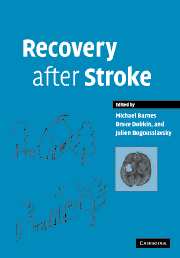Book contents
- Frontmatter
- Contents
- List of authors
- Preface
- 1 Stroke: background, epidemiology, etiology and avoiding recurrence
- 2 Principles of recovery after stroke
- 3 Regenerative ability in the central nervous system
- 4 Cerebral reorganization after sensorimotor stroke
- 5 Some personal lessons from imaging brain in recovery from stroke
- 6 Measurement in stroke: activity and quality of life
- 7 The impact of rehabilitation on stroke outcomes: what is the evidence?
- 8 Is early neurorehabilitation useful?
- 9 Community rehabilitation after stroke: is there no place like home?
- 10 Physical therapy
- 11 Abnormal movements after stroke
- 12 Spasticity and pain after stroke
- 13 Balance disorders and vertigo after stroke: assessment and rehabilitation
- 14 Management of dysphagia after stroke
- 15 Continence and stroke
- 16 Sex and relationships following stroke
- 17 Rehabilitation of visual disorders after stroke
- 18 Aphasia and dysarthria after stroke
- 19 Cognitive recovery after stroke
- 20 Stroke-related dementia
- 21 Depression and fatigue after stroke
- 22 Sleep disorders after stroke
- 23 Technology for recovery after stroke
- 24 Vocational rehabilitation
- 25 A patient's perspective
- Index
8 - Is early neurorehabilitation useful?
Published online by Cambridge University Press: 05 August 2016
- Frontmatter
- Contents
- List of authors
- Preface
- 1 Stroke: background, epidemiology, etiology and avoiding recurrence
- 2 Principles of recovery after stroke
- 3 Regenerative ability in the central nervous system
- 4 Cerebral reorganization after sensorimotor stroke
- 5 Some personal lessons from imaging brain in recovery from stroke
- 6 Measurement in stroke: activity and quality of life
- 7 The impact of rehabilitation on stroke outcomes: what is the evidence?
- 8 Is early neurorehabilitation useful?
- 9 Community rehabilitation after stroke: is there no place like home?
- 10 Physical therapy
- 11 Abnormal movements after stroke
- 12 Spasticity and pain after stroke
- 13 Balance disorders and vertigo after stroke: assessment and rehabilitation
- 14 Management of dysphagia after stroke
- 15 Continence and stroke
- 16 Sex and relationships following stroke
- 17 Rehabilitation of visual disorders after stroke
- 18 Aphasia and dysarthria after stroke
- 19 Cognitive recovery after stroke
- 20 Stroke-related dementia
- 21 Depression and fatigue after stroke
- 22 Sleep disorders after stroke
- 23 Technology for recovery after stroke
- 24 Vocational rehabilitation
- 25 A patient's perspective
- Index
Summary
Introduction
A belief in the superior efficacy of early treatment has a long history in the literature of rehabilitation. This belief probably has its roots in clinical experience and logic. Wylie (1968) argued that earlier treatment is generally held to be superior in the lore of medical care. Subsequently, many investigators have studied the relationship between timing of rehabilitative efforts and patient outcome. These studies have varied greatly: the early group ranging from less than two days to up to three months post-onset. Yet, a correlation between earlier onset of rehabilitative efforts and better recovery for stroke patients has been recurrently documented, and authors have concluded that early rehabilitation is important to maximize patient recovery and to improve cost-effectiveness (Wylie, 1968; Wojner, 1996).
In order to discuss if early rehabilitation is useful, we have to distinguish rehabilitation practiced during the “acute phase” of stroke from “early rehabilitation” practiced in rehabilitation centers during the first three months. Furthermore, the organization of the rehabilitation team and the intensity of therapy has to be defined, varying from conventional wards or stroke units with only physiotherapy to stroke units with interdisciplinary teams and intensive rehabilitation programs.
In this chapter, we shall try to give an overview of the literature available describing the different definitions of early rehabilitation in order to offer some actual practical criteria for selecting patients for early rehabilitation (i.e. rehabilitation in acute phase) and give guidelines for the constitution of the interdisciplinary staff, the intensity of treatment, and the essential approaches of neurorehabilitation of the stroke patient.
Pathophysiological aspects of activation of recovery in the acute phase
Several studies have tried to determine whether structural or functional enrichment of animals' living environment or post-ischemic training could alter the pattern of delayed neuronal cell death and influence functional impairment. Farrell et al. (2001) observed 84 gerbils with cerebral ischemia (some with prior ischemic conditioning) and animals with a sham procedure for 60 days in which animals were housed either in enriched animal housing with functional training or in standard (non-enriched) housing. The hippocampal neurons (CA1) were investigated in all groups by electrophysiological and histological techniques. They concluded that early, intensive intervention after ischemia can improve functional outcome but this is accompanied by increased brain damage.
- Type
- Chapter
- Information
- Recovery after Stroke , pp. 189 - 208Publisher: Cambridge University PressPrint publication year: 2005
- 1
- Cited by



